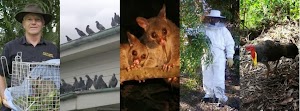Not all migratory animal visitors to Queensland are pests that require the attention of the specialist services from Peter the Possum Man. From June to November each year Queenslanders can witness some of nature’s largest and most spectacular animals as they visit our part of the world. Up to 10,000 Humpback Whales migrate past South East Queensland on their way north to their calving grounds in northern tropical waters. Once their calves are born, they travel back with their young to the Antarctic, swimming past SE Queensland on their return journey.

So where are the best places in SE Queensland to view the annual Humpback Whale migration? Hervey Bay is the whale watching capital of Australia as many Humpback mothers and their calves stopover for a few days rest in Hervey Bay on their way back to the Antarctic. There is also a marine sanctuary near Moreton Island where the Humpback Whales rest before continuing their journey. This area is within easy reach of Brisbane by boat, with many half-day and full-day whale watching cruises available leaving from Redcliffe and Tangalooma. If you do join a cruise, or decide to explore in your own boat, you need to remember whales are a protected species, with many rules and regulations governing how close you can get to them. If you are in a boat on Moreton Bay, you can’t be within 100m of a whale, or 300m if there are three or more other boats closer to the whale.
You also can’t bring your boat between members of a pod of whales. If you are on a jet ski or swimming, you can’t be closer than 300m to a whale . It is also worthwhile knowing that it is illegal to touch a whale, make a noise to attract a whale or disturb it, or to intentionally feed a whale. These are endangered animals – so every action needs to be taken to allow them free space to breed and grow unhindered.
Humpback whales are not Queensland’s only whale visitors. Blue Whales, Minke Whales, and Pilot Whales all visit its waters. Unfortunately, these are much harder to spot as they spend more time beneath the surface of the sea.







